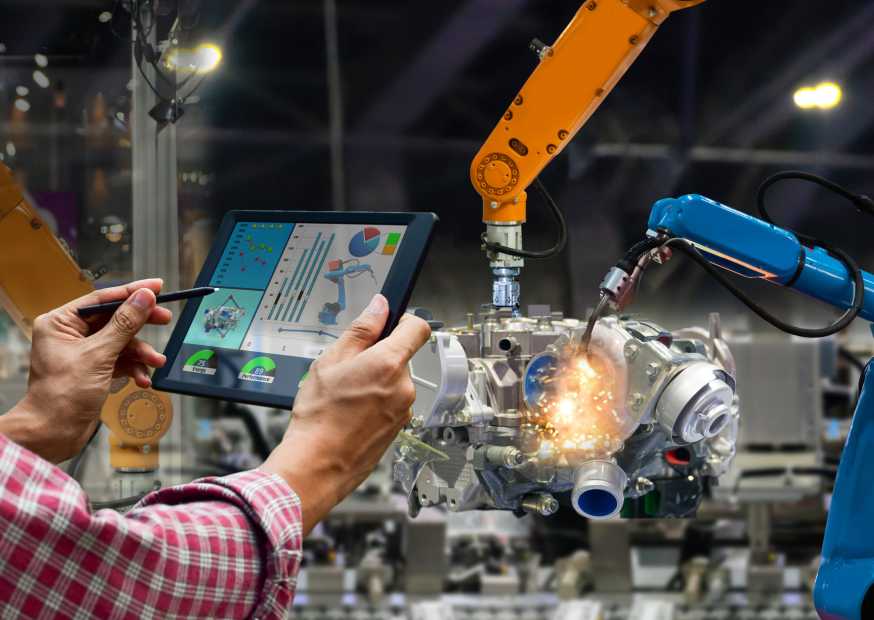- marketing admin
- Articles
Industrial automation is a productivity enhancing savior keeping industrial assets up and functional at all times. Industrial Robotics are a subset of the automation setup, called the IoT network, which enables the practical implementation of automation of different tasks in the manufacturing, mining, and oil and gas industries, in addition allowing coordination with other devices through real-time synchronization.
Robotics are an integral part of any automation in industries, and are selected appropriately based on the inherent advantages and disadvantages it has while assigned to work on any specific task. Based on this, robots are classified into five types which is discussed further in the following sections.
The present day automation has robots driving only a specific section of industries whereas the future of robots deployment in a mobile and random environment in any industry processes is the new horizon to explore for industrial robotics and automation enthusiasts. Robot-as-a-Services (RaaS), is also a possibility with customizable robots, modular in design, that can rightly fit in as an immediate automation solution, thereby reducing the implementation cost and time that is required for a custom robot build up from the scratch.
Choice of Robots
The robotics industry is working closely with various applications and are designing robots that are best suited for the places where they are deployed and possess the required capabilities, form factor to fulfill critical purposes. Some of the most classified robots that are under usage are discussed in the following sections. (The Future of Robotics and Automation Relies on Workers With Advanced Skills – Cincinnati Business Courier, 2020)
Articulated Robots
The robots in use currently in industries are articulated robots that mimic the behavior of human hands and are designed to emulate all intricate functions of the human arm. Built using actuators and brushless motors (BLDC) that do either rotary or reciprocating actions.
Typically these robots are ideal for welding purposes, material handling, and as helper arm assisting humans in tending metals and also in packaging super sized shipments that are too heavy and difficult to be handled using forklifts.
Automated Guided Vehicles (AGVs)
This is step further advancement is robots, which are mobile and follow a preplanned path that can be either in the form of tracks, lines or Infrared waypoints. They operate semi-autonomously and need an operator oversight to avoid any accidents. These robots are helpful in a closed environment with a fixed motion path and assisted guidance systems.
Warehouses inventory handling, components packaging and moving, material loading and unloading are ideal activities that best suit AGVs.
Autonomous Mobile Robots (AMRs)
These AI assisted real-time decision making robots are built with an onboard system that monitors and manages the state of the robots taking decisions autonomously. They mimic the working of a human brain and learn from the ingested or observed data that are continuously processed and analyzed on the fly to keep the robots mobile and autonomous. They need minimal to zero human intervention and can precisely do well defined jobs on the shop floor.
A practical version of AMR is the humanoid that falls under the AMR category and is often used to identify and act with a close similarity of human-like forms.
Hybrids
The innovation of integrating robots one with another can lead to a single autonomously functioning robot. An easy example will be combining the Articulated robots that mimic the functions of humans with an AMR. This combination reduces the human intervention from two machines to just one machine. It is handy for managing articulated robots remotely using an AMR deployed to handle or assist the functions of the Articulated robots based on the working environment.
The broader classification of the above types of robots based on their mobility as Fixed or Non-Fixed robots. All the above, falls under the Mobile robots category except the Articulated robot which is a fixed robot.
Benefits of Industrial Robots
The use of industrial robots is changing the way industrial processes, revolutionizing the way industries operate and reaping the benefits. Machines are at work for decades and the reliability was challenged due to the inefficiency, demanding computing power and networking of systems to process information in real time.
Improved efficiency
The advancements in industrial robots have matured to the extent that it is now accurate and consistent in doing tasks in a given time frame. It is crafted to handle tasks with zero to menial errors and helps in waste management of materials that can be further used by recycling. These tight precision industrial robots improve manufacturing efficiency and reduce defects and ensure first-time quality that saves a lot of time and resources.
High Payload lifting
The Articulated robots or Hybrid robots can assist personnel in the production floor handle heavy industrial machinery with less effort and improved safety. Using these robots, it is easy to access potential harmful areas and avoid unnecessary accidents at the workplace. Apart from moving heavy machineries, it also reduces the associated costs, in case any emergency occurs at the worksite.
Quality and Consistency
The robots are immune to human factors that affect the performance of the human workforce at work. Using industrial robots, it ensures consistency and order in the manufacturing process, thereby maintaining high productivity levels without compromising on the quality of the products. It also reduces the product defects when a recursive quality strategy is followed to fine tune the output from automation.
Future of Robotics and Industrial Automation
With the evolution of the fourth industrial revolution, nicknamed industry 4.0 is changing the way industries work today. The penetration of robots in industries is increasing rapidly as the market size for industrial robots is growing at a CAGR of 11.4% for the forecast period 2022-2029. (Industrial Robots Market Size, Share & Growth Report [2029], n.d.)
The power of computing, both edge and on the cloud, has improved productivity and performance of robots in real time industrial processes. This allows dynamic evaluation of yields easier and helps derive operational insights to understand and further strengthen the value chain of the work environment for humans and machines.
The most eminent difference between now and then in robotics is the capability to do networking of devices on the field.
Component to Product Assembly
In the industrial space, the role of robots is currently bound within the component manufacturing and there is potential to expand in the product assembly processes. The advanced ARM robots have greater potential due to its multi-axis arms that are capable of performing human arm-like movements to handle materials in the production line.
The modular designs allows re-configuration of these robots to the needs of the different automation requirements which reduces the product life cycles of developing a task specific robot.
Robots-as-a-Service (RaaS)
An extended model of the IaaS, where infrastructure is leased on subscription basis, robots can be modularized and designed with customizable features ready to use in situations of acute demand. These on demand robots can work in a pay-as-you-use subscription service model, similar to the AWS compute services model, except this is going to be a physical product working in a real environment.
It eliminates the need for maintenance and avoids cost intensive ownership of the robots paving way for mass manufacturing of robots at a lower entry cost. This opens the door to many potential demands and invites businesses of all sizes to explore the affordable automation solution. (The Future of Robotics in Manufacturing | Manufacturing, n.d.)



